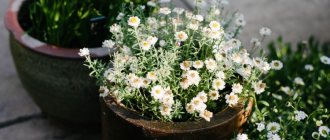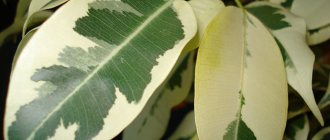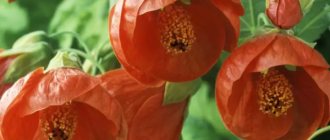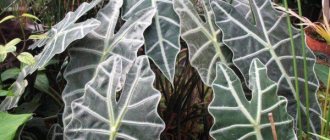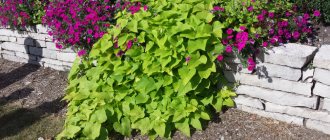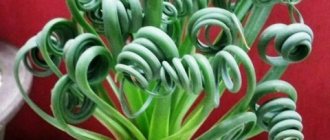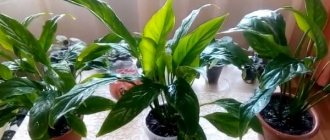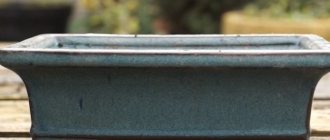A low exotic plant of the Araceae family, native to the tropical countries of South America and Asia, Spathiphyllum Wallis, Latin name Spathiphyllum wallisii, looks great in compositions with other types of plants, and is used for decorating home, office and public spaces. Discovered by the biologist Wallis in the 19th century in the forests of Colombia and brought to Europe by him. The plant was named after its discoverer. The second name of this flower is “women’s happiness”, because its influence on relationships and helping women in family life has been repeatedly noticed.
Description
Spathiphyllum Sweet Chico is an indoor shrub plant that belongs to the hybrid type.
Its characteristic feature is the absence of a stem. The plant can reach a height of 70-80 cm. The leaves have a rich green tint. They are on long petioles and have an oval shape. Spathiphyllum foliage has a smooth coating with straight veins. During flowering, the plant appears a large number of arrows growing from the soil. Because of them, spathiphyllum looks like a fan.
The inflorescence is usually white or white-green. It is surrounded by an outer petal, which is also called the veil. When the plant fades, the outer petal takes on a greenish tone.
Bloom
The plant begins to bloom at the age of 1.5-2 years. The flowering period lasts from late March to early September. The flowers are a yellow spadix wrapped in a white bract (growing white spathiphyllum is described here). Before flowering, fertilizers with potassium and phosphorus should be added to the soil, since during this period the plant needs more nutritional compounds and moisture. Mineral substances are responsible for the duration of flowering and enhance the protective properties of the plant.
As soon as the flowers bloom, you cannot add fertilizer until the end of the flowering period. During the period when buds appear, it is necessary to water the plant abundantly. At this time, it is necessary to maintain the temperature not lower than +16…+18°C.
What to do if it doesn't bloom?
In order for Spathiphyllum Wallis to bloom, you should adhere to the following recommendations:
- Buds appear only if the root system fills the volume of the pot. Therefore, you should not plant a small indoor flower in a large container.
- Do not flood the plant with water. Spathiphyllum should be watered only after the soil has completely dried.
- It is necessary to avoid direct sunlight on the flower. It should be remembered that the plant is light-loving. Therefore, it needs good lighting; you should not place the pot in a too dark area of the room. Do not leave the plant in a draft.
- You will need to lift the roots of the plant and touch the soil stuck to them. In some cases, moisture can stagnate in the soil, causing the plant to weaken. In such a situation, it is necessary to dry the soil and replant the plant.
In order to make the plant bloom, you should not water the spathiphyllum abundantly for some time. After this, you need to put the pot in a cool room. Spathiphyllum, like other plants, has many subspecies. Therefore, on our website we have materials about spathiphyllum Silver, Domino, Sweet Chico, Picasso, Alana, Sensation, Strauss, as well as about red varieties.
Feeding spathiphyllum
Lack of feeding during flowering has a detrimental effect on spathiphyllum. When choosing a fertilizer, do not forget that a large amount of nitrogen will stop flowering and leaf growth .
During the warm period, the flower is fed once a week, and in winter and autumn - once every three weeks. The basic rule is to feed exclusively wet soil .
From March to September, when the flower is actively growing , spathiphyllum should be fed with complete mineral fertilizers at a concentration of 1.5 g per liter of water. You can also purchase fertilizers such as “Azalea” or “Flower” in the store.
Alternate fertilizing with mineral fertilizers in combination with diluted mullein brings no less good results. After feeding, spathiphyllum is watered generously.
Step-by-step instructions: how to propagate?
Reproduction of Spathiphyllum Alana is possible by dividing the rhizome and cuttings.
Dividing the rhizome is considered a fairly common method, which is quite useful for the mother plant. The resulting cuttings are considered ready-made material for propagation; they simply need to be planted in a container. To do this, follow several rules:
- planting is carried out at a temperature of 20°C;
- before removing the cuttings, the plant is thoroughly watered;
- For transplantation, use a container with a diameter of about 15 cm.
When cuttings, the role of planting material is a leaf rosette, which is cut from the mother plant. Further, reproduction is carried out according to the following plan:
Is it possible to keep dried roses and other dried flowers at home? how to bypass the ban
- the cuttings are placed in a container with water for 2-3 weeks until roots form;
- to prevent stem rotting, add activated carbon to the water (1/2 tablet per glass of water);
- when the roots reach a length of 2-3 cm, the plant is planted in the soil.
Problems during cultivation
Spathiphyllums are very hardy and relatively immune to pests. But they do not resist drafts and heavy smoke in the room. Characteristic signs of diseases and treatment options:
- The leaves are turning pale. This occurs due to lack of light. Lighting needs to be increased;
- Drops leaves and buds. The pot is not cramped enough, there is little light, lack of fertilizer. Errors in the conditions of detention should be corrected;
- The tips of the leaves dry out. The air is too dry. Perhaps there are heating devices nearby, then the flower is transferred to another place. Also treated with frequent spraying;
- Brown spots on the surface of the leaves. This is a sign of over-fertilization. The plant needs replanting;
- Why do the lower leaves turn yellow or black and then fall off? The cause is often overwatering, which leads to root rot. The irrigation regime should be changed. Another reason is a lack of nutrients, the plant needs to be fed;
Damaged spathiphyllum leaves
- If the leaves partially darken and cobwebs appear, the plant has been attacked by pests.
Spathiphyllum is most often attacked by spider mites and aphids. It is necessary to carefully examine the leaves. If harmful insects are detected, treat the plant with insecticides.
News:
Article date: 03/11/2007 (updated 02/17/2008)Family: Araceae (Araceae).
Homeland: tropical America, Philippine Islands, tropical rainforests in Venezuela, Colombia, Guiana, Brazil
Flowering: depending on care, either once a year (spring), or twice a year - in spring and autumn-winter
Growth: fast.
Light: diffused without direct sunlight, can grow in partial shade.
Temperature: spring-summer prefers temperatures within 22-23°C, not lower than 18°C. In the autumn-winter period, the optimal temperature is not lower than 16°C, as this inhibits the development of the plant.
Watering: in the spring-summer period and during flowering, abundant; between waterings the top layer should dry out. In autumn-winter, watering is moderate. When watering, the substrate should not dry out, but should not be excessively waterlogged.
Air humidity: high, spraying is useful. To increase humidity, you can place the pot with the plant on a tray with damp expanded clay, moss or other porous material.
Feeding: from March to September and during flowering with complete mineral fertilizer of low concentration (1-1.5 g per liter of water).
Dormant period: from October to January, temperature not lower than 16°C, moderate watering.
Replanting: in the spring, as needed, when the roots fill the pot.
Reproduction: cuttings and division of rhizomes.
The genus Spathiphyllum (Spathiphyllum Schott.), according to the latest data, unites 45 species of perennial stemless plants with short rhizomes of the aroid family, some of them are very decorative. Spathiphyllums are common in tropical America, the Philippine Islands, and tropical rainforests in Venezuela, Colombia, Guiana, and Brazil.
The name "spathiphyllum" comes from two Greek words: "spata" - bedspread and "phyllum" - leaf. Indeed, the shape of this plant’s spathe resembles an ordinary leaf, except that it is devoid of a petiole and is white. The leaves are basal, oval or lanceolate, entire, with a strongly protruding midrib and thin, parallel-running laterals. Petiole widening at the base. The inflorescence is a spadix, on a long stalk, with a veil at the base. It blooms for a long time, for several weeks or more, the usual flowering time is spring. Re-blooming may occur in late summer, autumn and even winter. After flowering is completed, the spadix and spathe are removed, cutting the peduncle as low as possible.
Spathiphyllums are very popular plants, valued both for the beauty of the leaves and the beauty of the flower, and are not too demanding to care for. However, they require constant spraying and abundant watering; these factors must be taken into account when purchasing a plant.
Kinds:
Spathiphyllum heliconiifolium (Dryand) Schott . Homeland - tropical rainforests of Brazil. Plants up to 1 m tall. The leaves are oblong-elliptical, 35-50 cm long and 20-25 cm wide, shortly pointed, glossy, dark green, wavy at the edges. Petiole 75-90 cm long, vaginal from the base (5-9 cm long). The inflorescence is a spadix, 8-10 cm long, white, then darkening to almost black. The spathe is oval, almost 2 times longer than the cob, 15 cm long and 10 cm wide. A valuable ornamental plant suitable for growing indoors.
Spathiphyllum cannifolium (S. cannifolium (Dryand.) Schott). Homeland: Venezuela, Guiana, Thailand. A plant with large, bright green, ovate leaves similar to canna leaves. A white-green spathe with very fragrant flowers on a yellowish-green spadix. A wonderful indoor plant.
| S. cannifolium |
Spathiphyllum spoon-shaped (S. cochlearispathum (Liebm.) Engl.). Homeland - Brazil. This is a large plant up to 1 m high, with oblong-elliptical leaves. The length of the leaves is 30-40 cm, width is 15-20 cm. The leaf blade is dark green, glossy, wavy at the edges, supported by a long (up to 50-70 cm), strong petiole. Inflorescence spadix, white. The bedspread is oval, long.
| S. cochlearispathum | S. cochlearispathum |
Spathiphyllum profusely flowering (S. floribundum (Linden & Andre) NE Br.). Homeland: Colombia. The plant is medium-sized, up to 50 cm tall, the leaves are oval-lanceolate, 20-25 cm long, 9-12 cm wide. The number of leaves can be more than 40. The spathe is white. Blooms profusely and for a long time. Flower buds are laid in the axils of healthy leaves, on which the harvest of next year's inflorescences depends. In the USA, the variety Mauna Loa from Spathiphyllum profusely flowering. A plant with a pure white broadly lanceolate or broadly elliptical, gracefully concave spathe 10-12.5 cm long and up to 5-6 cm wide. A creeping stem with extremely short internodes, most often underground. Petioles 10-15 cm long, leaf blade 15-20 cm long, 5-6 cm wide, bright green, oblong-lanceolate or oblong-elliptic, long-pointed at the apex (tip up to 1.5 cm). Peduncle up to 25 cm long, flowers collected in a spadix 3-5 cm long. on a very short leg. 'Mauna Loa' is an excellent cut and pot plant (blooms throughout the year), (the inflorescence lasts for more than a month when cut).
| S. floribundum 'Mauna Loa' | S. floribundum 'Mini' |
Lovely spathiphyllum (S. blandum Schott). Homeland - tropical America. A plant with dark green, elongated lanceolate leaves with an extended tip. The petioles are long and strong. The inflorescence is a spadix, surrounded by a greenish-white blanket, which is shaped like a small flag. Therefore, the popular name of this flower is flagolite. It blooms from April to June and has a large number of inflorescences.
| S. blandum | S. blandum |
Spathiphyllum Wallis (S. wallisii Regel). Homeland - tropical rainforests of Colombia. A plant 20 to 30 cm high with a short rhizome and a rosette of dark green oblong-lanceolate graceful leaves. The cob is white, the spathe is narrow, three times as long as the cob, at first pure white, then turning green. Flowering is abundant and long lasting. The plant is unpretentious and shade-tolerant. Grows well indoors.
| S. wallisii | S. wallisii |
Plant care:
Spathiphyllum can grow in diffused light and in partial shade. In the shade, spathiphyllum leaves become dark green, the leaf may take on a more elongated shape, flowering will become rare or stop; if you find these signs, then the plant does not have enough lighting. The plant should be protected from direct sunlight; keep this in mind when placing the plant on south-facing windows. Northern windows are well suited for spathiphyllum, but on southern windows spathiphyllum blooms more abundantly and longer and is much larger in size.
Spathiphyllum is a heat-loving plant; in spring and summer it prefers temperatures within 22-23°C, not lower than 18°C. In the autumn-winter period, the optimal temperature is not lower than 16°C, as this inhibits the development of the plant. Temperatures below 10°C are critical, as at this temperature plants rot and may die. Spathiphyllums do not tolerate drafts.
Spathiphyllum needs to be watered all year round. During flowering, in spring and summer, abundant watering is required, possibly from a tray, but the top layer of soil should dry out between waterings. In winter, watering is moderate. The earth ball should not be allowed to dry out; at the same time, stagnation of water in the pot can be detrimental to the plant. For watering and spraying, use only settled water (it must stand for at least 12 hours). Drooping spathiphyllum leaves indicate that it lacks moisture. Excessive watering causes dark spots to appear on the leaves.
All spathiphyllums love high humidity. Spraying with soft water, a tray with damp moss or sand, the atmosphere of the aquarium, a warm shower from time to time - all this has a beneficial effect on the growth of spathiphyllums - natives of humid climates. It is no coincidence that the tips of their leaves are elongated into a sharp dropper and droop down: this is how the leaves get rid of excessive flows of tropical downpours. In the dry air conditions of most rooms, even with timely spraying (2 times a day), drying of the leaf tips is observed. When the spathiphyllum blooms, it is necessary to spray it carefully so that water does not get on the cover and the cob. From October to January the plant has a dormant period, but if it is provided with sufficient air humidity, spathiphyllum can bloom in winter.
During the active growing season (from March to September), spathiphyllums are fed with low concentration complete mineral fertilizer (1-1.5 g per liter of water). You can feed it with a special fertilizer for indoor plants that does not contain lime, for example “Azalea”, “Flower”, etc. Good results are obtained by alternate feeding with solutions of mineral fertilizers and fresh mullein diluted in a ratio of 1:15 or 1:20. After fertilizing and before fertilizing, the plants are watered generously with water at room temperature. If spathiphyllum blooms in winter, then it is fed with the same fertilizers after 3-4 weeks. The appearance of brown spots on the leaves indicates an excess of nutrients.
The signal for replanting is the roots, which have filled the entire volume of the pot with the plant. It is better to replant in the spring. Spathiphyllum is sensitive to root damage; replant carefully.
The soil for replanting is slightly acidic (pH - 5-6.5). Excess moisture harms the plant, so the soil must be loose so that excess moisture can flow freely into the pan. Spathiphyllums feel quite good in ordinary humus, to which you need to add brick chips and pieces of charcoal. A mixture of equal parts of leaf and turf soil, humus, peat and river sand is suitable. You can use a ready-made substrate for aroids by adding pieces of charcoal to it. Good drainage is necessary. Choose a pot for spathiphyllum that is slightly larger than the previous one; too large a pot will slow down flowering. It is better to spill the soil with a dark pink hot solution of potassium permanganate. After transplantation, plants need warmth, moderate watering, and frequent spraying, all of which contribute to rapid rooting. Plants take root better if greenhouse conditions are temporarily created for them (covered with transparent material), but do not forget to ventilate them.
Spathiphyllum is propagated in spring by cuttings and dividing the rhizome. Rooting of cuttings is carried out in damp sand in a warm room (it is advisable to use a mini-greenhouse). After the roots have formed on the cuttings, they are planted in a substrate of the following composition: 1 part leaf soil, 1 part peat soil, 0.5 parts turf soil, 0.5 parts sand.
It is convenient to propagate spathiphyllum by dividing its powerful creeping underground rhizome into several parts. Propagation by dividing the rhizome is best done in the spring when transplanting. The shortened stem of spathiphyllum begins to branch: new growth points are formed, young leaves unfold in several places. If you do not want to grow a very overgrown bush, then you can divide it so that each fragment remains with a growing point and a piece of rhizome (by the way, it is recommended to divide the plant at a temperature of 20-21C; each piece of rhizome should bear at least 2-3 leaves). Delenki are planted in 12-15 cm pots in a ready-made substrate for aroids, consisting of humus, unsifted leaf soil, peat and sand (1: 1: 1: 0.5). Add pieces of broken brick, tree bark and coal, and if possible, add dry mullein. You can use a substrate of a different composition: leaf, coniferous soil, humus, peat, sand (2:2:2:2:1) or leaf, peat, coniferous, humus soil, sand (2:4:1:1:1) with the addition of pieces of charcoal.
Possible difficulties:
Spathiphyllum does not bloom: The reason may be that the pot is too spacious; spathiphyllums bloom when the roots entwine the entire pot.
The tips of the leaves dry out: The reason is low air humidity. In apartment conditions this is inevitable, even with frequent spraying.
Dry brownish-yellow spots appear on the leaves, similar to burns, although direct sunlight does not fall on the plant: A possible cause is overwatering. Water the plant only when the top layer of soil dries out.
The leaves around the edges turn black and dry, then die completely, sometimes young leaves that have not yet untwisted dry out: The cause may be excessive waterlogging of the soil, or dry air. There may also be a lack of minerals (nitrogen, phosphorus).
Liquid wax is often used to add shine to the leaves. Spathiphyllum is sensitive to clogged pores on the leaves, so liquid wax should not be used!
Damaged by: spider mites, scale insects, aphids.
Author of the article: Marina Mityaeva
Discuss the article and care on the forum
We discuss growing spathiphyllum on our flower forum
How to propagate spathiphyllum - we share our experience on propagation
Share the link
Materials used in the article:
Indoor floriculture / R. Milevskaya, Y. Vies. - Mn.: Book House, 2005. - 608 p., ill.
https://prathom.swu.ac.th/panmai/show_img.asp?ID=7-10110-002-029.2
https://commons.wikimedia.org/wiki/Spathiphyllum_cochlearispathum
https://www.puyallup.wsu.edu/Hort/Hort332/images/plantlist/peace%20lily%20'Mona%20loa'.jpg
https://www.agristarts.com/spath_mini.htm
https://www.jardin-mundani.com/galeriafotosRS.htm
https://www.hoffmanflowers.com/product/the-ftd-spathiphyllum/display
Other similar varieties and their features
Spathiphyllums include a large number of varieties. Each variety has its own characteristics. It is necessary to highlight some varieties that have common characteristics with the Sweet Chico variety.
Sweet Lauretta
Bred in 2001, therefore it is considered one of the youngest varieties.
Spathiphyllum Lauretta has oblong leaves of light green color. You can see light veins on the leaves. The leaves are located on a high spine.
The inflorescences are white with a yellow stamen. The bush can reach large sizes, the width of an adult plant reaches 85 cm. This is an undemanding plant, Sweet Lauretta is a spathiphyllum that grows quickly and does not require complex care.
Names of flowers for creating a balcony flower garden photo
Variety Sweet Lauretta
Sweet Silvio
One of the most attractive varieties. A distinctive feature is the elongated leaves and the height of the bush up to 80 cm. The leaves are lush and grow very quickly.
The inflorescence is large, oblong in shape. The variety is distinguished by small sinuous leaf edges. This feature appears in an adult plant.
Spathiphyllum Sweet Silvio
Sweet Rocco
A houseplant characterized by large leaf sizes. They have an elongated shape. The width of an adult bush can reach up to 60 cm, height up to 90 cm.
Methods of propagation of Kalanchoe
The bush blooms with large inflorescences that are slightly concave inward and hide a white pistil with a yellow coating.
Cultivar variety Sweet Rocco
Sweet Benito
The plant is distinguished by a large number of inflorescences during flowering. The leaves on the plant are bright green, narrow, elongated towards the top.
For reference! This variety is resistant to diseases and changes in lighting. Can be grown in large quantities to decorate rooms.
Spathiphyllum Sweet Benito
Step-by-step instructions for care at home
Selecting a location
Spathiphyllum Domino is planted in bright places, on window sills without direct sunlight. Dry air and drafts should be avoided. It is forbidden to keep the plant under direct air conditioning.
What should the soil be like?
The best soil for growing plants is a special mixture. Sold in a flower shop. You can make the mixture yourself, for this you will need to combine in equal parts:
- sand;
- peat;
- humus;
- leaf soil;
- charcoal;
- fine tree bark.
Landing
- When planting a plant, the bottom of the pot is filled with expanded clay.
- Soil is poured out to half the container.
- Having distributed the roots, the plant is installed and covered with the remaining mixture.
- The soil is lightly compacted for stability and watered.
Temperature
The most optimal temperature for keeping Spathiphyllum Domino is from 18 to 24 degrees.
In winter, avoid temperatures below 15 degrees and reduce watering, and in summer, avoid direct sunlight, which burns the leaves, and water more often. Temperatures above 28-30 degrees are dangerous for both the plant and the soil.
Watering
Watering is carried out with room water. In the hot season, one watering and spraying every three days is enough. Depending on the climate, increase the amount of watering, but not water, so as not to contribute to rotting of the roots. In winter, the plant only needs 1 watering per week.
Top dressing
Fertilizing is only needed during flowering. Use calcium and phosphorus or complex fertilizer. When choosing mineral fertilizers, you should avoid nitrogen in the composition - because of it, the plant stops blooming.
Important! Fertilizer is applied at a concentration of one and a half grams per liter of water.
Trimming
Spathiphyllum Domino does not require mandatory pruning. Only dead leaves and flowers are removed. If there are too many leaves for the size of the pot, it is better to replant the plant.
Transfer
The plant is replanted at the end of winter, when the nutritional system has not yet awakened. The pot should be 4-5 centimeters larger than the root of the plant. Due to the thickness of the root part, the flower is replanted with soil. Drainage is placed at the bottom of the pot, the plant is installed and covered with earth, compacted. After transplantation, it requires abundant watering.
How to plant?
You can plant a new plant using:
- seedlings obtained by dividing an adult plant;
- seeds.
- When planting a new plant as seedlings, you need to choose the right pot. It should be only 3-4 centimeters larger than the root of the seedling.
- Pour perlite into the pot and top with nutritious soil, which can be purchased at any store. You can prepare it yourself by combining sheet soil, peat, sand, ordinary soil, and charcoal in equal parts.
- The seedling is carefully placed in the pot, and the roots are covered with earth.
In the future, be sure to monitor the moisture content of the soil in the pot. In general, spathiphyllum loves high humidity, so you need to spray it more often.
When planting a plant with seeds:
- You need to find a container with a wall height of 3-4 centimeters. Pour nutritious soil into it, sow the seeds, you can simply press the seeds with your fingers. Sprinkle a little soil on top and water.
- Cover the top with transparent glass to create a miniature greenhouse. The room temperature must be maintained at a level from 23 to 25 * C.
- Raise the glass from time to time to prevent stagnation and mold.
- After the first shoots appear, continue to water and ventilate until they reach a height of 3 centimeters.
- Transplant the seedlings into small cups.
- When the seedlings grow to 6 centimeters, transplant them again into large cups.
- After three months, the seedlings are transplanted into pots and placed in a permanent place. After two weeks they begin to feed.
Possible problems in growing spathiphyllums
Before rushing to treat a plant that has suddenly lost its beauty, it is worth analyzing its care. Often it is the grower’s mistakes that lead to the flower being attacked by diseases and pests.
A diseased plant looks unattractive
You should not expect rapid flowering from a young plant; only a mature plant whose roots have completely occupied the pot is capable of this. Other common problems include:
- Yellowed leaves - insufficient watering and old soil.
- If the tips become yellow, the reason must be sought in excessive water hardness.
- Drying shoots and their loss - low air humidity, can be solved by placing a tray of water nearby. It's no use spraying!
- Blackened ends of the leaves indicate problems with the watering regime. By varying watering schemes, you can recognize your mistakes.
As for pests, the most dangerous are spider mites and aphids, which surround the plant throughout the foliage. To defeat the first one, you need to wash the plant in a soapy solution - the pest will not tolerate such a procedure. Aphids are more tenacious, you will have to act immediately and repeatedly (possibly). It is necessary to treat the flower with a solution of nicotine sulfate (1 g per 1 liter of water). If a scale insect has attacked, treat the spathiphyllum with a tobacco-soap solution, then only with soapy water. The finishing touch is treatment with insecticides with a suitable composition.
Spathiphyllum is a bright and unusual plant that can transform an interior even alone. It does not require special conditions, just water it regularly and keep it away from sunlight. A huge variety of varieties allows you to choose an option that suits the size and shade of the leaves.
Caring for spathiphyllum at home
Beginning flower growers are happy to add this plant to their home collections, since it does not place any particularly high demands on its maintenance.
Spathiphyllum flowering
With proper care, spathiphyllum has a long flowering period - from one and a half to 2.5 months.
The size of the cob varies depending on the type and variety of spathiphyllum, but the color is almost always snow-white, occasionally light green. That is why the plant is often popularly called “white sail”, although “female happiness” is a more common name.
According to legend, on her wedding day, the goddess of love Astarte breathed a small amount of her happiness into the flower so that it would bestow it on all marriageable girls. The botanical name of the plant is also associated with its inflorescence and is translated from ancient Greek as a blanket-leaf.
After the spathiphyllum has faded, you should cut off the arrow at the very base
Temperature
Spathiphyllums are heat-loving plants and develop normally only when the room temperature is maintained between +18 and +25 degrees above zero. They can tolerate heat only if there is a sufficient increase in air humidity, but the critical point for them is no more than 32 degrees. In winter, it is undesirable to allow the thermometer to drop below 15 degrees Celsius. The flower does not like drafts and cold that blows from an open window.
Spraying
Air humidity is an important condition in growing spathiphyllum. The plant responds favorably to spraying, especially in the summer heat.
However, the plant is able to adapt to dry air with a constant humidity level of no more than 40-50%.
Lighting
Experts argue about the plant’s light requirements: some consider it shade-tolerant, others, on the contrary, prefer bright but diffuse lighting. Direct sunlight damages glossy foliage, leaving burn marks. Lack of lighting affects the unevenness or lack of flowering.
The optimal location for the flower would be to place it on windowsills in an eastern or western direction, shaded during active sun hours, however, even with artificial lighting, the plant develops quite normally.
Watering
The plant instantly reacts to the lack of moisture in the soil by lowering its leaves, however, turgor is quickly restored immediately after watering.
The flower does not tolerate overdrying of the soil mixture well, part of the root system dies, and the leaves, which seem to have restored their elasticity, often subsequently turn yellow and dry out anyway. Moisturize spathiphyllum 2-3 times a week during the summer heat with soft, settled water. In winter, watering is reduced to once a week. However, they try to prevent stagnation of water in the pan and drain the excess liquid.
Soil for spathiphyllum
The plant is grown in a loose fertile substrate consisting of equal parts:
- humus,
- peat soil,
- leaf soil and sand plus twice the amount of turf soil.
Mix everything thoroughly and add a few small pieces of brick chips and charcoal. A layer of expanded clay or pebble drainage is placed at the bottom of the flower container.
Feeding and fertilizer
The plant needs constant feeding both in summer and in winter, if it continues the growing season and does not rest. From April to September, the spathiphyllum flower in indoor conditions is fertilized once every 15-20 days with complex mineral fertilizers with the same content of potassium, phosphorus and nitrogen. In winter, fertilizing is reduced to once a month and universal fertilizers with a reduced dose of nitrogen are chosen.
Spathiphyllum transplant
More mature plants can be transplanted into a larger flower container less often - once every 3-5 years. However, for each plant it is necessary to make a decision individually - quickly growing bushes with a large number of daughter side branches may find themselves cramped in the pot and they will refuse to bloom.
When replanting, you should not immediately choose a pot that is much larger in volume than the previous one. The roots will take a long time to develop the internal space of the vessel to the detriment of the expected flowering.
Trimming
Homemade spathiphyllum does not need regular pruning
It is important to promptly remove faded ears to initiate re-blooming, as well as cut off yellowed leaves at the very base
Spathiphyllum transplant
If the care was correct at first, then the spathiphyllum should be transplanted as soon as the roots fill the volume of the pot. Flower growers advise replanting once a year .
Spring is the optimal time for transplantation. When replanting a flower, be careful, as spathiphyllum has sensitive roots that are easy to damage. Buy a slightly acidic substrate or mix yourself 2 parts turf soil, 1 part leaf soil, 1 part peat soil, 1 part sand and 1 part humus. You can also use regular humus with the addition of brick chips and charcoal. Don't forget about good drainage.
The pot for transplanting spathiphyllum is chosen in size, 1-4 cm larger in diameter than the previous one . A large pot will slow down flowering and the plant will begin to actively grow leaf mass.
After transplantation, spathiphyllum must be kept in a warm place, watered moderately and sprayed frequently . It will be useful to create greenhouse conditions for the flower for faster rooting.
Is the plant poisonous or not?
Spathiphyllum Picasso juice contains calcium oxalates. In case of accidental contact with it, children and people prone to allergic reactions may experience the following symptoms:
- urticaria on the skin;
- difficulty breathing;
- severe headaches;
- general weakness of the body;
- drowsiness;
- sweating
Pets may have a different reaction. Oxalates are slightly soluble in water, settling in the renal pelvis, forming sand and causing urolithiasis.
Cats eating leaves can cause swelling of the oral mucosa and burns of the esophagus and stomach.
In order to provide timely help to your pet, you need to pay attention to its general condition.
If juice poisoning occurs, you may experience decreased activity, increased breathing and heart rate, and may also experience thirst, vomiting, and diarrhea.
The animal must be given activated charcoal to drink, at the rate of 0.5 grams per kilogram of the cat’s weight, and the pet must be taken to the veterinarian.
Step-by-step instructions for care at home
Selecting a location
Pots are best installed on east or west windows. Exposure to direct sunlight is contraindicated for spathiphyllum cupido.
Important! Avoid drafts and cold air from the air conditioner.
What should the soil be like?
Spathiphyllum Cupido requires loose, slightly acidic soil. It is better to purchase a substrate in the store; a universal mixture for aroid or tropical flowers is suitable for this variety.
You can prepare the mixture yourself:
- Turf soil – 2 hours.
- Leaf soil - 1 tsp.
- High-moor peat – 1 tsp.
- Coarse river sand – 1 hour.
- Charcoal – 0.5 tsp.
- Brick chips – 0.5 hours.
It is advisable to add medium pieces of tree bark and superphosphate to the substrate. The additive should not exceed 10 -15% of the total amount of substrate.
Landing
The procedure for planting Spathiphyllum Cupido is quite easy:
- 2 cm of drainage base is poured onto the bottom of the pot - expanded clay, pebbles, pieces of bark.
- The special mixture is filled in half.
- A planting bush is placed vertically in the middle of the pot.
- The roots spread evenly.
- Pour in the remaining substrate and lightly compact it with a spatula.
- The stem is slightly buried and the substrate is pressed down around the trunk.
- Water generously.
- When the soil settles, pour a small amount of substrate into the pot.
- The leaves are sprayed.
- The seedling should be kept under a cellophane cap for 4–5 days.
Temperature
Spathiphyllum Cupido is a heat-loving flower, the optimal temperature is 19 – 25°C.
Reference. The temperature should not be lower than 16 – 15 °C.
Watering
The main condition for caring for Spathiphyllum Cupido is good watering. Also in the summer it is necessary to spray every day, the flower is very moisture-loving. The leaves are wiped with a damp sponge for additional moisture.
Water for irrigation is taken only purified at room temperature. In winter, watering is reduced by 2 times. The water in the pan should not stagnate; after watering, excess water must be drained.
Top dressing
Spathiphyllum Cupido is fertilized in the spring with any mineral fertilizers in a ratio of 1 - 2 g per 1 liter of water. Young flowers are fed once every 3 weeks. It is enough to fertilize an adult flower once every 30 days. In winter, the amount of fertilizer is reduced.
When spraying, you can add liquid fertilizers to the water - this is an excellent substitute for root fertilizers.
Nitrogen fertilizing is useful for increasing the greenery of the bush. For flowering, potassium-phosphorus fertilizers are preferred in a 1:1 ratio. You can fertilize the soil with organic fertilizers. Typically, feeding is alternated for better effect.
Trimming
After flowering, the flower stalks should be trimmed after the spikelet turns dark.
Not only the flower is cut, but also the stem to the very base - this gives the opportunity for a new bud to ripen.
Important! To ensure that the leaves are large and have a rich color, you need to cut out the lateral shoots when replanting.
Transfer
Transplantation is usually performed after flowering, in June. Young spathiphyllum Cupido is replanted every year 3–4 times. The transshipment method and its technique are used:
- You should definitely take a pot one size larger than the previous one.
- Drainage is laid out at the bottom with a layer of 2 cm.
- The soil in the pot is well wetted.
- The flower is carefully removed along with the earthen lump.
- The bush is transplanted into a new pot, the void is filled with a special substrate.
- Abundant watering is necessary, in the next 2 - 3 days you should not water, just spray the leaves.
Immediately after purchase, the soil in the purchased container must be used for replanting.
Aerial roots - small tubercles at the base do not need to be too deep when planting. Subsequently, they will take root and serve as additional support for the flower.
Indoor spathiphyllum flowers: care and video tips
We bring to your attention a video clip from one of the popular TV shows, where we will talk about caring for spathiphyllum and the signs associated with this indoor flower.
[youtube https://www.youtube.com/watch?v=NUZGexzeZUw&w=700&h=395]
The spathiphyllum flower is unpretentious in care, that is, even “newbies” in the field of growing houseplants can cope with its cultivation. Spathiphyllum is especially valuable because it is able to assimilate nitrogen oxide and formaldehyde , which are released in abundance in the apartment by thermal insulation and furniture made from particle boards. It is necessary to take into account the basic recommendations of gardeners for caring for spathiphyllum.
Reproduction
The plant reproduces in 3 ways:
- Dividing the bush. It is better to transplant in the spring. The separated part of the plant must have at least 3 strong leaf rosettes and a fragment of a healthy rhizome. Before dividing, the root should be well saturated with water, washed, and untangled.
- Seeds. With this propagation method, the plant will bloom only after 3 years. The advantages of this method include the fact that spathiphyllum grows more hardy and strong, less demanding on air humidity.
- Cuttings. It is carried out in the warm season. Cut off the leaf rosette and add water to it until the root appears. Then they are transplanted into a pot of a suitable size and covered with film.
Reproduction of spathiphyllum
Rooting cuttings and dividing rhizomes are the main methods of propagating spathiphyllum. In spring, the rhizome of the flower is divided into several parts so that each individual shoot has 2-4 leaves. Next, the separated parts are planted in small pots filled with ready-made substrate for aroid plant species.
Reproduction by dividing the rhizome of spathiphyllum should be carried out at a temperature of 20-22°C .
The cuttings are rooted in damp sand and after the formation of petioles they are transplanted into a substrate consisting of equal parts of leaf and peat soil. To this composition should be added 0.5 parts of sand mixed with the same amount of turf soil.
Care instructions
Selecting a location
Spaciphyllum Sweet Chico needs a lot of light and warmth, so it is better to place this plant on the east, north or west side. The flower should not be exposed to direct sunlight.
What should the soil be like?
Spaciphyllum takes root best in loose soil with a neutral pH. To create ideal soil, you need to mix humus, peat, sand and turf soil in equal proportions.
Landing
It is best to plant spaciphyllum in late winter - early spring.
- First of all, drainage is placed at the bottom of the selected pot, and then pre-prepared soil is poured.
- The seeds need to be scattered evenly over the surface of the soil, slightly deeper into the ground. Then the soil is sprayed with clean water using a spray bottle and covered with polyethylene. This covering must be removed every day for a while to give the plant a chance to ventilate.
- When the first shoots form (usually this happens after 10 days), the film can be removed and the pot placed in a well-lit place. After the first leaves appear, you need to pick.
Temperature
In summer, the optimal temperature for spathiphyllum is 22-24 degrees. In winter, the minimum permissible temperature is 16-17 degrees. At temperatures below 13 degrees, flower growth slows down, this negatively affects the condition of the plant as a whole.
Watering
For spathiphyllum, abundant watering is important, which should be done 2-3 times a week. For this purpose, use only distilled water.
It needs to be poured into the pot very carefully so that it only gets on the ground.
Spathiphyllum leaves should be sprayed with a spray bottle to prevent them from drying out. This procedure is carried out about twice a week. In winter, this can be done less often.
Top dressing
The most suitable time for applying fertilizers is from March to September. To do this, you need to use complex mineral compositions. In order not to harm the plant, the solution should have a weak concentration - no more than 1 g per liter of water. The flower must be watered well before and after fertilizing.
It is not recommended to use fertilizers more than once every two weeks. To make flowering last longer, you need to use fertilizers that include phosphorus and potassium.
Trimming
When flowering is completed, the peduncle must be cut off so that it does not absorb nutrients. You need to cut it as close to the rhizome as possible. If there are dried and diseased leaves, they also need to be cut off and the cut areas treated with charcoal.
Transfer
When the rhizome has spread to the entire pot, you need to replant the plant. The transshipment method is ideal for this.
- It is necessary to remove only a small part of the soil from the root system so as not to damage them.
- Rotten rhizomes must be cleaned.
- To replant the plant, use a pot larger than the previous one to give the roots room for further growth.
- After this, watering must be reduced, and the pot must be covered with film again and ventilated a couple of times a day.
Watering the plant
The flower needs watering all year round , since humidity is one of the conditions for abundant flowering and maintaining the life of the plant. If you notice drooping leaves of a flower, you should water it generously.
During the break between watering, the top layer of soil should have time to dry out . In spring and summer, spathiphyllum needs abundant watering, since the main flowering activity .
In winter, you can water the flower as needed. Black spots on the leaves are a sign of excessive moisture in the spathiphyllum, so it should be watered less often. Spraying 2-3 times a day also has a beneficial effect on the growth and flowering of spathiphyllum.
However, do not forget that during flowering the flower should be sprayed extremely carefully to avoid water getting on the cob and the cover . Before spraying and watering, let the water sit for at least 13 hours.
Description of common species and varieties
There are such decorative types of spathiphyllum:
- Tall;
- Medium height;
- Miniature.
They all differ in the shape and color of the leaves and inflorescence. All species and varieties have one common feature - the color of the flower, which always remains white.
Spathiphyllum species and varieties that are considered the most popular among gardeners are described below.
Spathiphyllum Alana
The alana variety is a medium-sized species, growing up to 50 centimeters in height. The leaves are dense with a glossy surface. It differs from other varieties in the color of the bract, which has a convex vein on the inside.
Alana variety
During the period of flower growth and blooming, it turns green. When the flower fades, the greenery spreads to the entire bract. The leaves, unlike other varieties, are directed strictly vertically.
Spathiphyllum Wallis Regel
It grows no more than 30-40 centimeters in height. The leaves are inclined downwards. The spadix at the flower opening stage is white in color, and as it develops it becomes light green.
Spathiphyllum cupido
A hybrid obtained from the Spathiphyllum Wallis variety. This pearl has a low (up to 50 cm), lush bush. The leaves are thin, elongated. The color is dark green with a glossy surface. Spathiphyllum Silver Cupido has a white, pointed bract with a cream-colored spadix.
Variety Cupido
Spathiphyllum Vivaldi
It has a shortened rhizome. The leaves are thin, drooping, wide at the base and gradually tapering towards the top. The color is dark green. A well-defined vein is visible in the middle of the leaf. The bract is light green on the outside and white on the inside. The cob is light cream.
Spathiphyllum gigantea
A hybrid with tall (up to 1.5 m) bushes. The leaves are dark green, glossy. The inflorescences are large (up to 50 cm), initially white, and as the flower blooms they acquire a light green tint.
Spathiphyllum Lauretta
A variety characterized by low growth, no more than 30 centimeters. The leaves are light green, wavy at the edges. The veins are pronounced. The bract is white with a creamy spadix.
Variety Lauretta
At the end of flowering, both the spadix and the bract acquire a light green tint.
Spathiphyllum Domino
It is distinguished by dark green leaves with long white stripes, which are randomly located throughout the leaf blade. The leaves are ellipsoid and pointed at the tips. This spathiphyllum variety grows up to 50 cm in height. The bract is oval, snow-white.
Variety Domino
Variety Gemini
It is often confused with Domino, believing that they are the same thing. Spathiphyllum Gemini and Domino, the difference between these flowers is that Gemini has dark green leaves with gray or cream spots along the lateral veins.
Spathiphyllum regal
It is considered a real giant among all plant varieties. Grows up to 70 cm in height. It is distinguished by large leaves and bracts. The leaves are thin, bright green, glossy. The bract has a concave shape.
Spathiphyllum wallisii and Hedera helix (decorative ivy)
They are one of the few plants that can cleanse a room of formaldehyde fumes.
Interesting. Often in nurseries you can see a flower similar to spathiphyllum, which has the same green, glossy leaves and a bract of the same shape, only of a different color. In fact, this plant is called Antarium (male happiness) - an ornamental plant with red flowers, which is often called red spathiphyllum.
Description and photo of the plant
The plant is low, up to a maximum of 30 centimeters . The leaves are lanceolate, large, up to 6 centimeters wide and up to 25 centimeters long. The leaves are dense, shiny with a well-distinguished center line and veins. Collected in a basal rosette, no stem. The petioles are green, almost equal to the length of the leaf.
See photos of this beautiful plant:
The inflorescence is a white spadix, can be up to 3 centimeters long, it is protected by a white perianth, or a blanket called a “sail”, three times the length of the inflorescence itself. The flowers do not fade for 2-3 weeks . After flowering ends, the cover turns green.
Diseases and pests, means of combating them
The plant is very often susceptible to diseases if not properly cared for. The most common problems include:
- yellowing of leaves - such symptoms may indicate a lack of moisture; to eliminate this, you need to water the plant and spray the leaves every few days;
- the leaves turn black - this problem occurs when the root system is diseased. In such cases, the plant must be transplanted to a new place of growth and the root must be carefully examined. Rotten and damaged areas must be removed;
- leaves curl - such symptoms indicate dry air in the room and excessive amounts of sunlight. The plant needs to be shaded.
In some cases, pests can be seen on the plant. At the first symptoms, measures should be taken, otherwise the plant may die. The most common pests on indoor plants are:
- aphids - feed on plant sap. To combat it, you need to wipe the leaves with a soapy solution;
- spider mite - forms small tubercles on leaves and shoots, the pest destroys the leaves and leads to the death of the flower. To fight, you need to use onion infusion or soapy water.
To prevent the appearance of diseases and pests, it is necessary to follow the rules of care and add nutrients in a timely manner.
Spathiphyllum is often used to decorate rooms. The variety Sweet Chico is a prominent representative of the species. Cultivation involves following fairly simple care rules; the flower itself grows quickly and has an attractive appearance.
Is the houseplant poisonous?
Spathiphyllum Picasso contains poisonous juice, which can cause severe poisoning if parts of this plant are accidentally consumed.
Therefore, care should be taken when growing this hybrid if there are small children and animals in the house. If its juice enters the body, it can cause inflammation of the mucous membranes of the upper respiratory tract and severe stomach pain.
A houseplant can also cause allergies in adults and children during its flowering period. Considering that it blooms for quite a long time, you should not leave it in the house if you have an allergic reaction to it.
3. Varieties and varieties of spathiphyllum:
3.1. Spathiphyllum "Picasso" - Spathiphyllum "Picasso"
A relatively recently bred and rather low-growing, marbled, variegated variety, which is a spathiphyllum up to 50 cm high with basal glossy leaves, painted in a wide variety of combinations of green and white, each leaf of this plant is unique. This species blooms just like ordinary spathiphyllums; it only needs very good lighting to maintain its bright color.
3.2. Spathiphyllum “Sensation” - Spathiphyllum “Sensation”
The tallest and most unpretentious variety with large, hard, glossy, dark green, oblong-lanceolate leaves. The flowers are collected in an inflorescence - a spadix - and are surrounded by a large white blanket. Flowering is very long, but occurs only in good lighting conditions.
3.3. Spathiphyllum "Domino" - Spathiphyllum "Domino"
Relatively compact, broad-leaved, variegated variety. The plants have long and narrow, hard, dark green leaves with long petioles. The leaf blades are glossy, covered with small, white and light green stripes and spots. The flower bedspreads may also have stripes of a green tint.
3.4.Spathiphyllum Chopin - Spathiphyllum “Chopin”
Beautiful large, large-leaved spathiphyllum with abundant and very long flowering. The leaves are on strong long petioles, the leaf blades are oblong, glossy, dark green in color, with pronounced branched veins.
3.5. Spathiphyllum Cupido - Spathiphyllum "Cupido"
Small evergreen perennial plants, reaching a height of 15 - 30 cm. Leaves with slightly corrugated edges, emerald green. Flowering is abundant and long-lasting; the flowers have large, creamy-white spathes, but as they fade they can turn green.
3.6. Spathiphyllum Alana - Spathiphyllum Alana
An elegant, decorative, small-leaved variety with bright green oblong leaves. The flowers' spathes are small, pointed, greenish-white. The plant reaches a height of 30 cm.
3.7.Spathiphyllum Angel Baby - Spathiphyllum “Angel Baby”
A beautiful, variegated, narrow-leaved, perennial spathiphyllum with narrow, thin leaves, painted predominantly in a delicate light green color with thin dark green stripes. The midrib is usually highlighted in a dark shade of green.
3.8.Spathiphyllum profusely flowering - Spathiphyllum floribundum
A compact herbaceous perennial plant up to 30 - 40 cm high. The leaves are oblong - oval, glossy, up to 20 cm long. Small green, yellow or orange flowers are collected in a cylindrical inflorescence - a spadix and are surrounded by a large spathe up to 20 cm long, white or green.
3.9. Spathiphyllum Mauna Loa
A spectacular variety with narrowly lanceolate, glossy, dark green leaves and tall peduncles rising above the foliage. At the tops of the flower stalks there are cylindrical inflorescences with small cream or yellow flowers, surrounded by a wide white or greenish spathe with a green stripe on the outer surface.
3.10. Spathiphyllum cannifolium
A beautiful broad-leaved variety. The plants have large, broadly oval, dark green leaves on long, slightly curved petioles. These bushes look very impressive during the flowering period - when they throw out vertical tall peduncles with single, large, white or slightly greenish spathes.
3.11. Spoon-shaped spathiphyllum - Spathiphyllum cochlearispathum
Giant spathiphyllum, which is an evergreen herbaceous perennial plant up to 1 m high. With good care, it can reach a height of 1.8 m. The leaves are glossy, green, have an elliptical or lanceolate shape, up to 65 cm long with a petiole. Large white spathes can appear throughout the year and remain attractive for up to 30 days each.
3.12. Lovely or pleasant spathiphyllum - Spathiphyllum blandum
Plants with oblong, elliptical leaves. The edges of the sheet plates are often corrugated. During the flowering period, it decorates itself with small, oblong, green or white blankets. Inflorescence - spadix consists of numerous green, yellow or cream flowers.
You might also be interested in:
Chlorophytum
Calathea
Dracaena
Anthurium
What do the fruits look like?
After flowering ends and the spadix and spathe turn green, seed ripening occurs after the sail withers and dries out.
The seeds have a curved shape and are located inside the berry, formed in place of the flower.
To obtain seeds, it is necessary to carry out artificial pollination . But, according to experienced gardeners, growing a plant from seeds is a rather labor-intensive process.
Possible problems in growing
Although the flower is considered quite unpretentious in care, it can be attacked by pests, or if not properly cared for, it can get sick.
Diseases of flowers of the genus Spathiphyllum
From a draft, the plant becomes sick and begins to shed its leaves. It often happens that the flowers on the plant become smaller, the leaves turn pale and growth slows down.
In this case, it is necessary to provide the flower with timely application of mineral fertilizers. Due to too dry air, the tips of the leaves begin to dry out, so it is very important to constantly spray. When watering with hard or cold water, as well as insufficient soil moisture, the leaves on the flower begin to turn yellow. If the watering regime, lighting or fertilizing rules are not followed, the plant will stop growing and stop blooming.
Frequent pests of spathiphyllums
- Spider mite. In case of severe damage, insecticides are used.
- Shield. The leaves are washed with soapy water and treated with tobacco crumbs.
- Aphid. Treat with special chemicals.
- Mealybug. The leaves should be treated with alcohol.
Additional Information. Many people wonder whether spathiphyllum is poisonous to humans or not. When keeping it at home, you need to know: the leaves of the flower contain calcium oxalate, which causes irritation of the mucous membranes and inflammation of the eyes, so before you start caring for the flower, you need to wear gloves.
Spathiphyllum will decorate any home. Its care is minimal, it is rarely susceptible to disease, and compliance with all growing conditions will allow you to admire it for a long time.
History of appearance
The flower was discovered in the tropical forests of Venezuela by biologist Russell Wallis in the 19th century, valued for its decorative qualities and brought to Europe. Based on this plant species, several new species of spathifuphyllum were obtained through breeding work.
It differs from other species in its miniature size . And besides, at the moment of flowering, the inflorescence is white and gradually turns green. Very easy to care for.
If you want to have spathiphyllum in your collection, you can start with Wallis - it will immediately become clear whether you can take care of such a plant or not.



